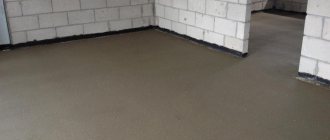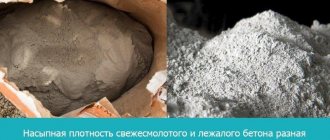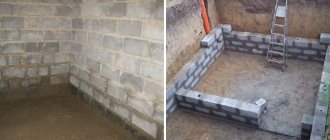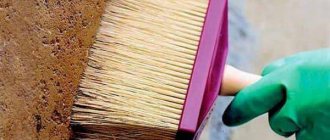Unused cement is a headache for the owner. It’s good if you managed to cover it, put it under a roof or protect it in some other way. Otherwise, the mass in the bags quickly becomes saturated with moisture, turning into an excellent monolith. And this is where the fun begins - it’s a pity to throw away the materials, but it’s unknown where to use them. So, what does the Internet say and can you believe everything? Let’s take a closer look at the advice of experienced experts.
Where to use hardened cement to good effect and what is pointless to do with it
If cement is stored in bags for a long time, and even in inappropriate conditions, then it can cake.
As a rule, after six months or a year, cement turns into stone, and it is simply impossible to use it for its intended purpose. But what to do if there are several bags of compacted cement, or even more. Is it possible to somehow restore cement for further use, and what should you know? Read this article from a construction magazine.
Stale cement - the opinion of professionals
The stale mixture loses its key property, so it is not recommended to use it for its intended purpose. Even if there is a small amount of crumbly mixture left in the bag, you should not use it to prepare the solution, as this may reduce the quality of the resulting mixture: it will be fragile, short-lived, and will not provide good adhesion to the surface.
The problem lies in the contact of the dry mixture with carbon dioxide: under its influence, the chemical properties of the substance change, so it becomes unsuitable for construction/repair work. Due to hydration, cement can no longer be used as an active binder.
Final word
The mortar for adhesion of bricks is selected taking into account building codes. To prepare, you need to calculate the amount of material consumption per 1 cubic meter of masonry in advance. This will reduce costs. The technical characteristics of the binder composition must correspond to the operational requirements of the structure. The strength of mortars depends on the brand of cement and the level of porosity of the sand. The density of concrete depends on the crushed stone fraction. Experts recommend studying the standards before preparing raw materials.
vote
Article rating
Is it possible and how to use cement that has hardened in a bag?
Along with stupid advice, there are recommendations that deserve attention. The following methods will help you make good use of fossilized sandstone in large quantities.
- Construction. It is used in buildings that are not subject to heavy loads: as a filler for foundations, when installing a fence, chicken coop, firewood shed, etc. To do this, the compacted monolith is crushed into pieces about 50 mm in size.
- Repair of coatings, decoration of garden paths. Cement stone is used together with crushed stone and construction waste in a ratio of 1:3. For 1 part of broken ballast there are 3 parts of additive. The resulting composition is indispensable when constructing blind areas, paths in the garden, etc.
- Creating a base for tiles. When pouring the floor, small and medium fractions are used for the “cushion” for finishing; in the installation of curb stones and benches.
- Repair of the local area. To use petrified material without residue, it is enough to crush it into stones, transport it in a wheelbarrow and fill up the holes and potholes that are full of them on the road in front of the house.
The material has a short service life, so the use of fossilized cement as the main binder is not recommended. It is necessary to take into account that when stored for 2-3 months in the original packaging under a canopy, its strength is lost up to 15%. After six months, this figure decreases by 50%. This is explained by the high ability of cement to absorb moisture from the environment, resulting in hardening of the material and a change in the chemical structure.
Photo: https://i.ytimg.com/vi/dzC5PNotJNk/maxresdefault.jpg
There is often information on forums about how to test the strength of old sandstone. To do this, it is recommended to grind it into dust, pour the cone, wait until it hardens, then break it with a hammer and compare the strength with the strength of a cone made of new cement, and then determine its area of application. But with the help of a cone, the mobility of concrete is determined, and not the strength of the compacted material. Therefore, grinding to dust will not give the old mixture the lost properties.
Video:
How long can cement be stored?
Cement packages should be stored in well-ventilated, dry areas on wooden or plastic pallets. Packages are stacked horizontally to a height of no more than 180 cm.
According to the requirements of GOST 30515-97 , compositions with a rapid hardening period are stored for 45 days, other types - no more than 60 days.
The warranty period of the goods is calculated from the date of shipment by the supplier, and not from the moment of receipt at the warehouse.
Expert advice: in order for the remaining cement to retain its properties for 1-1.5 years, it must be poured into dry sealed metal or plastic containers with minimal humidity or packaged in polyethylene.
You need to purchase cement in specialized stores, preferably from the manufacturer, immediately before starting construction work. The period from the date of manufacture to purchase should be no more than 1 month, otherwise the material will quickly lose its properties.
Cracks
A concrete monolith is a load-bearing element of various objects . Its characteristics determine the strength, durability, stability and service life of structures. Therefore, the formation of cracks in concrete is a serious concern for developers and homeowners. The appearance of cracks affects the further operation of the facility , in particular:
- affects the ability of the structure to absorb loads;
- reduces service life;
- reduces strength characteristics;
- worsens appearance.
Causes
The formation of cracks can be a consequence of the influence of external and internal factors. Cracks that arise as a result of the first factors are associated with the following processes:
- Bend. Cracks form perpendicular to the steel reinforcement rods, which stretch under the influence of bending loads.
- Shear acting diagonally with respect to the longitudinal axis of the reinforcement bar.
- Tensile stresses can coincide with the axis of the rods or act in parallel.
- Violation of the requirements for installing rods at the corners of the strip base . Installation of anchors performed with deviation leads to peeling of the protective layer protecting the reinforcement.
Internal deformations of the concrete mass cause stress associated with:
- Cooling of concrete , which occurs due to a sharp temperature difference on the surface or in depth. Defects arise as a result of rapid cooling of the mixture with water and air, while at the same time significant heat generation occurs. If the magnitude of the stress exceeds the strength characteristics of the concrete monolith, then surface cracks form. Temperature changes can cause cracks to disappear and reappear.
- Accelerated drying under the influence of direct sunlight, air temperature and wind.
In addition, it is possible to note other reasons:
Basalt mesh. Photo by Leroy Merlin
Failure to comply with the proportions of the solution . At first glance, preparing a concrete solution should not cause any difficulties. But in practice, it is enough to overdo it with one of the components, and the solution will be unsuitable for solving the tasks. In addition to cracks, it is possible to observe how the cement coating will swell, which is quite difficult to eliminate.
Violation of technology . In addition to maintaining proportions, it is necessary to control the shelf life of the components and their quality, this is especially true for cement. It is recommended to buy cement directly from the manufacturer or from official representatives of the factories. Be sure to use river sand that does not contain clay or earth. The grains of sand are approximately the same size. For greater purity, it is recommended to sift the sand.
Amount of water . One of the main reasons for the formation of cracks is an excessive amount of water in the solution. It is often possible to observe an excess of water in screed solutions, because... the liquid mixture is easier to pull. But due to excess water, the screed becomes deformed after drying. Long-term use leads to the coating cracking and crumbling.
Incorrect reinforcement. The reinforcement provides strength to the coating. But improper reinforcement leads to cracks. The mesh (or reinforcement) must be in close contact with the solution. It should be located at the top of the screed.
Rules of care
To avoid the formation of cracks in concrete after pouring, it is necessary to provide appropriate care, which involves a whole range of measures that help achieve operational strength. Failure to take these measures can cause deformation, reduce the rate of strength gain, and cause a violation of the integrity of the monolith. The set of measures consists of performing several tasks:
- ensuring minimal shrinkage of the solution;
- preventing accelerated drying;
- neutralization of temperature changes;
- prevention of mechanical impacts.
When pouring concrete, you need to remember to follow the following recommendations, you must... :
- maintenance work should begin immediately after concreting and be completed until the monolith is purchased at least 80% of its operational strength;
- check the integrity of the formwork , the absence of leaks and damage to the structure after concreting; defects should be eliminated within 2 hours after pouring, i.e. before the solution begins to set;
- protect the hardening solution from mechanical influences;
- to reduce moisture evaporation and prevent erosion, cover the surface with plastic film;
- maintain favorable humidity of at least 90% and control the hardening temperature of the solution;
- provide the necessary period for concrete hardening;
- do not allow moisture to evaporate, as a result of which the solution shrinks, which contributes to the formation of cracks;
- use deep vibrators for concrete, ensuring compaction of the solution and making it difficult for the composition to crack;
- protect the surface from exposure to wind and ambient temperatures that are lower than the temperature of the solidifying solution;
- moisten the monolith 8 hours after concreting, cover the surface with tarpaulin or burlap, which is periodically wetted;
- moisten concrete at ambient temperatures above +5 degrees Celsius;
- In addition, dehydration of the solution , which occurs when cement laitance leaks out through the cracks in the formwork, must not be allowed; Failure to comply with the requirements can lead to a decrease in strength, reduced resistance to weather conditions, and the formation of small cracks.
How to fix cracks
Cracks that form within the first 2 hours after pouring are eliminated using additional vibration compaction. Cracks formed after setting can be eliminated by rubbing in a composition for repairing concrete surfaces or a solution of cement and water in proportions of 3 to 1 with the addition of a plasticizer.
Surface defects that appear within 8 hours after concreting are eliminated in accordance with the following sequence of actions, you need...:
- clean the surface of deposits using a metal brush, wipe away defects using foam glass;
- remove dust from the surface using a vacuum cleaner;
- using a repair mixture to fill in defects;
- After the repair composition has cured, re-grind the surface.
Elimination of through cracks is carried out as follows, for this it is necessary...:
- clean the defect formation area;
- increase the width of the crack;
- clean the defect by removing dust and particles of the monolith using a brush or compressed air;
- fill the crack with a repair compound based on fine sand using a spatula;
- scrub the surface with a metal brush.
Small works: posts, patches, decorative structures
The third way to use old cement assumes that it has not petrified, but simply caked. In this case, the material will easily return to its free-flowing state.
Roll the bag on the floor for 2-5 minutes. If the shell has holes, you can pre-wrap it in film.
If hydration does not occur, the flowability of the cement will quickly recover. It happens that he is partially petrified. In this case, you can use a sieve to separate the cement from the stone.
Old cement is less durable than new cement. After the expiration date, it loses approximately 15% of the brand every month. For example, 500 cement (even crumbly) will become 200 after a year of storage.
Naturally, it is better not to use it in the construction of serious buildings (brick laying, foundation for a house). But for small jobs, the building material is quite suitable. With it you can:
- make posts in the garden;
- fill the garden path;
- fill the area for drying clothes;
- make decorative flowerpots, sculptures for the garden, etc.
Mix old cement with fresh cement in a ratio of 1 to 1. This will increase its grade.
Traditional methods of restoring characteristics and using material
Let’s say right away that not all advice on the Internet can be trusted. Let's start with those that turn out to be an obvious myth or difficult to implement.
Fry
To restore the characteristics, pieces of stone are fried in a frying pan. This is complete nonsense. To restore its properties, the monolith is fried at a temperature from +1300 C to +1500 C. Now let’s calculate how much a regular wood-burning or even coal stove produces - about +500 C. Obviously not enough.
Building a blast furnace for a bucket of fossilized cement is a costly affair; it’s easier to buy a dozen bags and start building. But if there is a cement plant nearby and you can take tons of stone from there, then roasting at +1500 C will return 99% of the properties of the material.
Grind into dust
Try to break the monolith with a sledgehammer. Stones bounce off reluctantly, stale ballast is difficult to break off. Now these stones need to be ground into dust. Of course, you can again build a mill and use millstones to grind stones into dust. But whether the idea is worth such work is something everyone decides for themselves.
Where can you use leftover polyurethane foam for your home and everyday life?
Use in construction
Many “Kulibins” advise diluting old cement with new cement (50/50) and using it to build a foundation.
But this is complete nonsense:
- By diluting the old cement in half, the owner only achieves a decrease in the quality of the new mixture. The monolith has lost its binding properties, so the mass will gain maturity and dry unevenly and will take much longer. The density of the mixture, the technical indicator of the finished product, also decreases.
- A 50/50 dilution is unacceptable. This violates building codes. At best, dilute in proportions of 1:10. That is, one part of old cement, 10 parts of new. The old one is ground into dust.
Experts are categorically against the use of old cement. Even ballast ground into flour does not have the properties of cement. Moisture from the air and gas lead to irreversible consequences. Therefore, the bag contains not cement, but cement stone with its own characteristics. No amount of abrasion into dust can return the material to its original qualities.
Shelf life of cement
This is an important aspect that deserves attention. Experts note that cement, under proper storage conditions, retains its properties for 45-60 days. After this period, the dry material begins to lose its chemical properties and basic consumer qualities, becoming unsuitable for construction work.
To prevent the cement from hardening prematurely, it is necessary to comply with the storage conditions established by the manufacturer:
- lay the bags on a floor made of wooden planks, avoiding direct contact with the concrete base or floor covering;
- wrap paper bags with plastic film, preventing moisture from penetrating into the dry mixture;
- cover the cement with a tarpaulin, taking into account the direction of ventilation.
The height of a stack of cement bags should not exceed 180 cm. Please note that the warranty period begins from the moment the cement is shipped by the manufacturer, and not from the date of purchase. That is why there is a possibility of purchasing a low-quality mixture. By following these simple tips, you can avoid premature hardening of the cement.
What to do if the composition in the bag has hardened
If the cement has hardened, do not rush to mix a solution from it. First you need to understand whether it will be suitable for preparing concrete, whether its use will affect the strength, reliability, and durability of the element, structure, or building.
Why does cement harden?
Cement hardens mainly due to moisture entering the powder. After all, the main condition for setting and hardening of cement is the passage of a chemical hydration reaction. Water and cement interact, form crystal hydrates, then go through two stages: setting and hardening of the mixture. Spatial connections are formed between the elements, after the destruction of which the cement will no longer return to its original form.
The question of whether it is possible to use hardened cement in a bag for its intended purpose is no longer worthwhile. It is definitely not suitable for performing initial tasks.
This happens because cement is a hygroscopic material and absorbs moisture from the environment. The process of hydration begins to occur in it - albeit not as actively as when mixed with water, but the material hardens and changes its structure at the chemical level.
How to dismantle a cast iron sewer:
- First, a pipe is selected that is located far from the riser. Use a hammer to break it; it is better to use a tool with a polymer or plastic base, because metal attachments lead to sewer clogging.
Break a cast iron pipe with a hammer
Personal protective equipment
Why does cement harden in bags?
Unpacked paper bags can turn to stone not only due to improper storage. Cement has an expiration date. It inevitably interacts with moisture from the air, which causes a hydration reaction. What happens is what they buy it for - it hardens. Only crystallization does not occur in the seams of the brickwork or in the layer of plaster, but directly in the packaging. The shelf life of the material is not calculated from the date of purchase, but from the date of issue. If upon purchase you find that lumps have formed in the corners of the bag, this indicates either improper storage or an expiring shelf life. According to GOST 10178-85, the shelf life for fast-hardening cement is 45 days. Other types of cement can be stored for 60 days. Already a month after production, the material loses some of its properties.
Preparatory work before installing a new toilet
Step 1. Clean the floor from glue, cement, silicone, etc. Remaining silicone can be removed using a string or knife. The cement must be knocked down with a hammer and chisel.
Step 2. Surface preparation.
- If the toilet was attached with bolts and after its dismantling the floor remained level. Try installing new fasteners in the old place. If the dowels go in too easily, it is better to drill new holes. To do this accurately, substitute the toilet. To pinpoint the location, connect the toilet to the drain. Insert a felt-tip pen into the mounting hole and make marks on the floor. If another type of fastening is provided, marks must be made on the outside. Then remove the toilet and make holes using a 4-5mm drill, turning off the hammer drill. Next, use a drill of the required diameter. Insert the dowels and remove the dust.
- If you had to remove cement. You can level the floor using cement or a special mortar. Depending on the composition, the cement screed dries in approximately 1-3 days. Make sure that the solution has hardened and can hold the fasteners. Then you need to make holes in the floor and hammer dowels into them.
What to do with cement stone
Let's move directly to the practical part, in which we will talk about the use of stale cement, brought to an acceptable consistency by any of the above methods. Even if there are large lumps left in the cement that cannot be crushed, you can use it to achieve various purposes.
Construction of structures
If you plan to build a small non-residential extension (workshop, garage, etc.) on a dacha or private plot, then old cement can be used as one of the components when constructing a foundation or load-bearing slab. It is important to understand that such a structure will not withstand heavy loads, but stale cement is quite suitable as a foundation filler.
In addition, it can be used for the manufacture of small architectural forms, since no increased requirements are placed on them. It can be:
- benches;
- flowerpots for flower beds;
- sides;
- fountains and decorative forms for artificial reservoirs.
Another practical application is the construction of greenhouses and chicken coops. In such a case, stale cement is quite suitable for use, since it will help save on the purchase of dry construction mixtures. If desired, you can make a concrete base for a canopy, gazebo or barbecue area in the backyard of a private house.
Decorate paths and restore surfaces
Surprisingly, cured concrete is often used in landscape design. It is great for arranging paths, sidewalks and small areas. Properly mixed mortar can be used to reconstruct small concrete forms: fence bases, paths and others.
Making a “pillow” for tiles
If you decide to lay garden tiles, then old cement can be used as a filler when constructing a screed. It will not have high strength, but it will help create an even coating that acts as an excellent base for the tiles. This way the platform or path will be smooth, without drops, bulges or other defects.
Repair the road in front of the house
Here we are talking about minor reconstruction work, for which there are no special requirements in terms of quality, reliability and strength. For example, if a garden path has cracked due to soil shrinkage, then there is no point in purchasing a bag of cement to restore it.
You can use the old mixture, since you will need a small amount to prepare the solution. This will be enough to fill cracks or eliminate chips, potholes and other defects.
Reducing concrete thickness
When deciding how to gouge a concrete foundation, you can use any of the listed methods. But not all of them are suitable if you need to remove a layer of concrete of a certain thickness, for example, to reduce the height of the screed. Theoretically, this can be done using acid.
But it is better to cut the entire area into small squares with a wall chaser, and then chop them off with a hammer drill. The surface will turn out to be very uneven and bumpy; you can level it with a grinder with a diamond cup attachment.
Grinding a concrete floor Source cdnassets.hw.net
A way to “invigorate” cement
As a result of hydration, hardened cement loses its binding properties and turns into cement stone. Compressed in a bag, it is no good, so it needs to be brought into a different state of aggregation.
Without unpacking the bag, you need to roll it on the ground. There is no need to try to break the stone.
The structure of such a stone is not strong, gradually external influences will destroy it, and the cement will become crumbly. After that it can be used.
The time period from the production of cement to its purchase should not exceed 1 month, otherwise the material is already considered to be of poor quality. The illustration for the article is used under the standard license ©dachnyedela.ru
Preparation of hardened cement for its intended use
Here everyone agrees that the cement that has turned into a lump must be crushed, and ideally crushed to the state of sand. The first thing you need to do is roll the bag. Perhaps it has caked, which happens very often, and after rolling it will crumble on its own. If this happens, you should not think that the building material can be used for its intended purpose. Its strength will be very low, which may lead to unexpected results.
If after rolling the cement remains in the same condition, it will have to be broken. And the best way to deal with this is a sledgehammer. And the smaller the factions, the better.
PHOTO: krsk.au.ru Well, where in Russia would you be without a sledgehammer, your first assistant?











